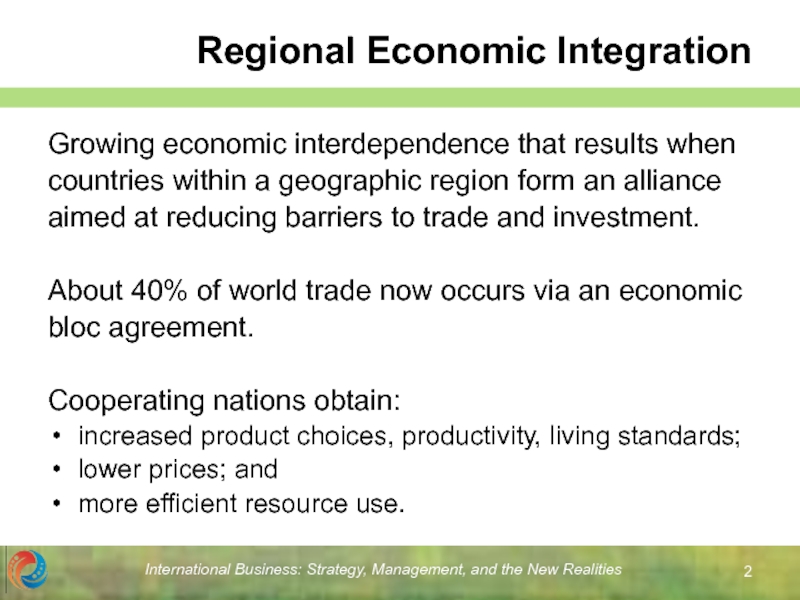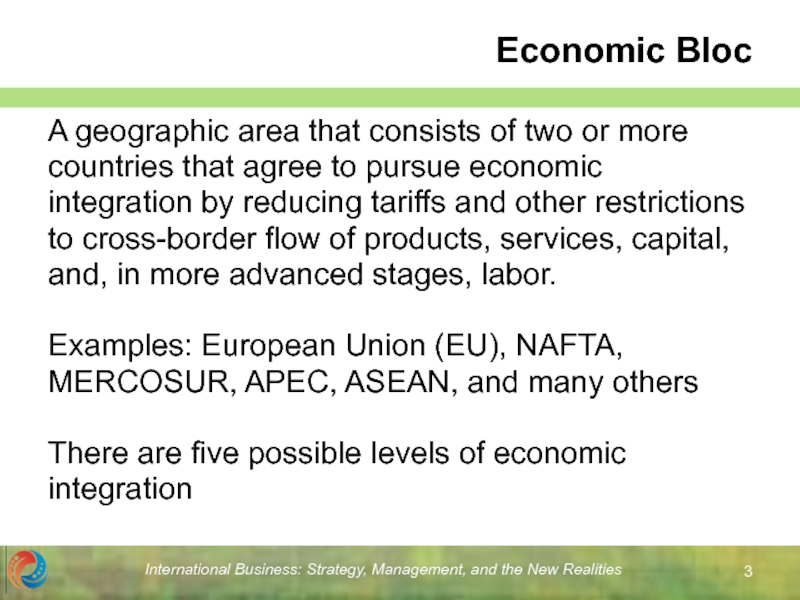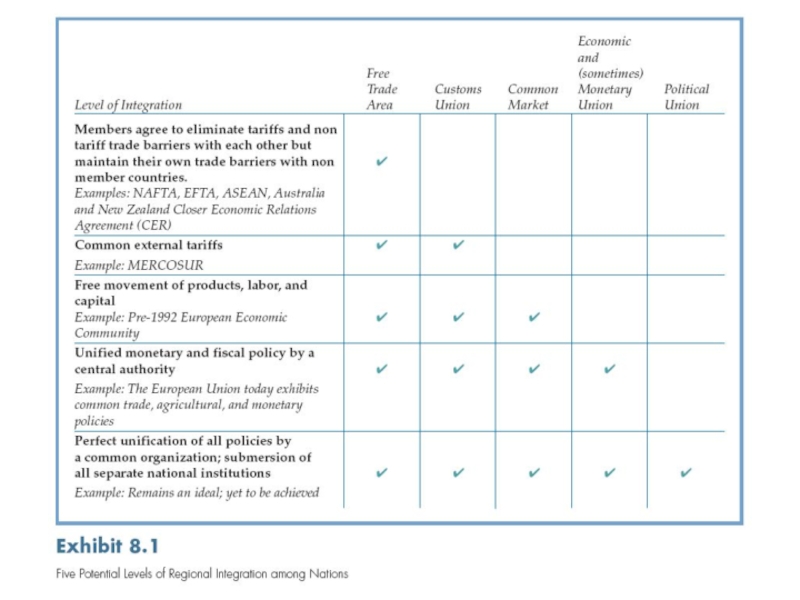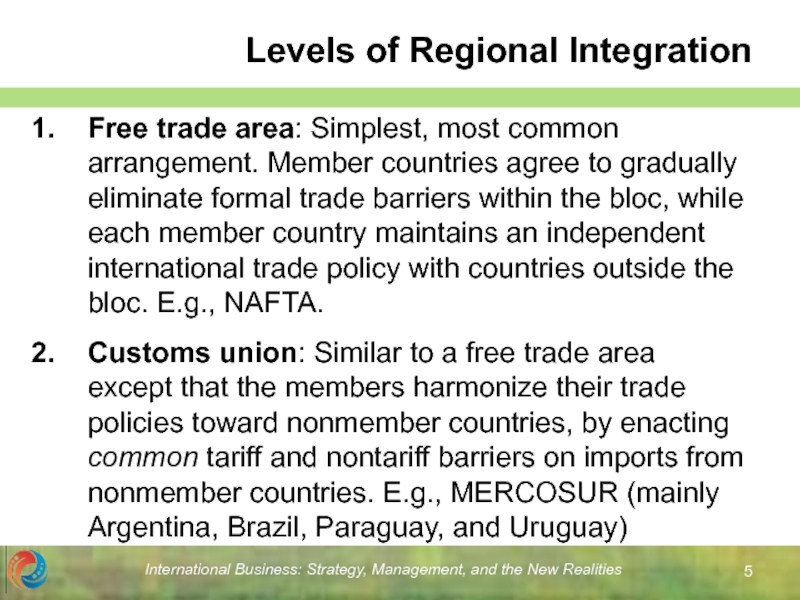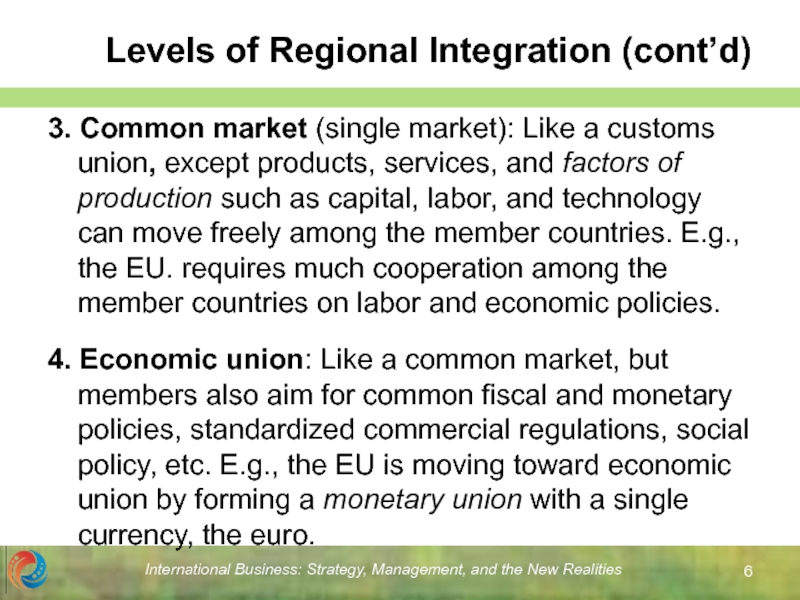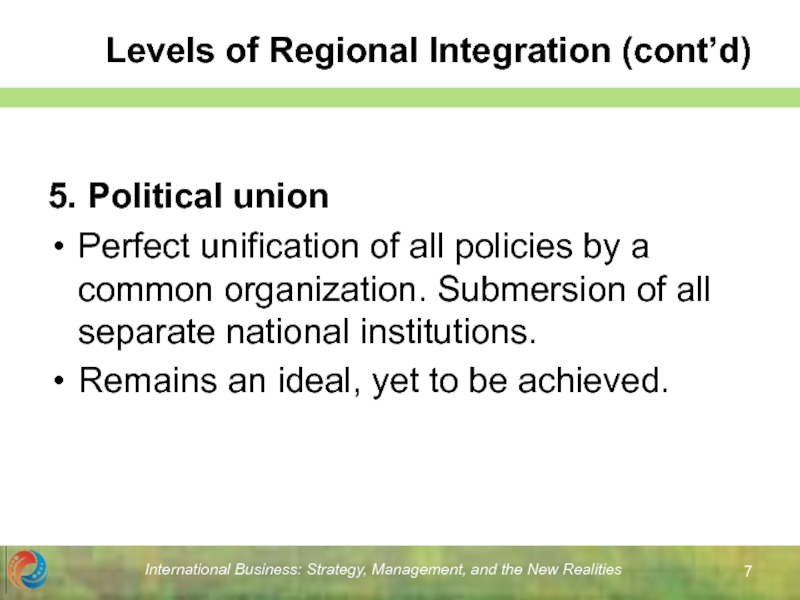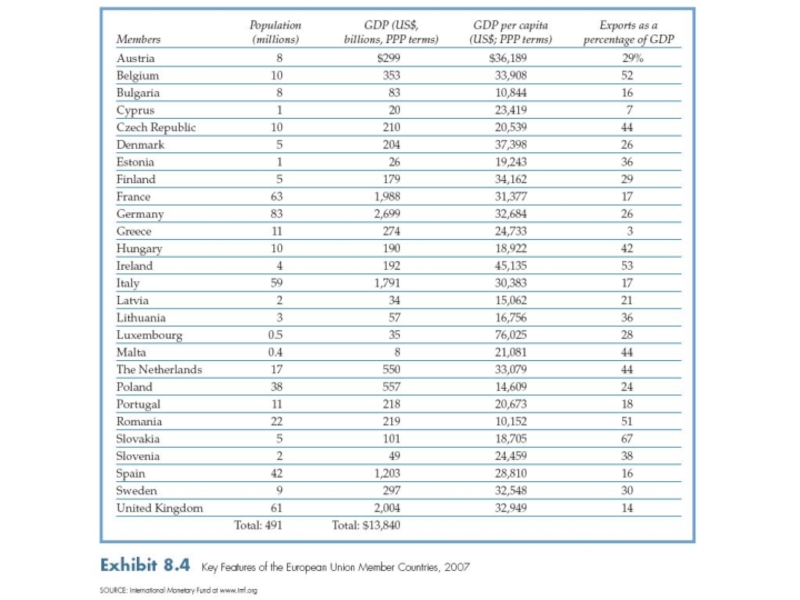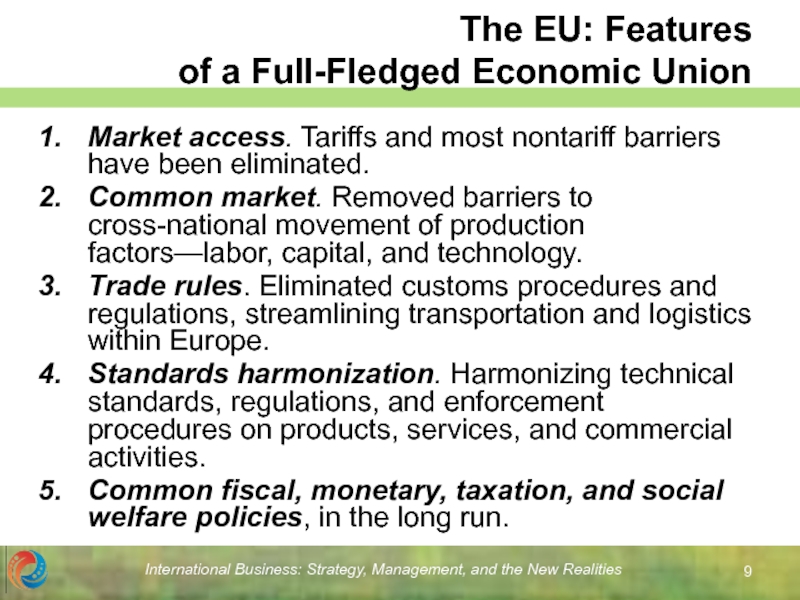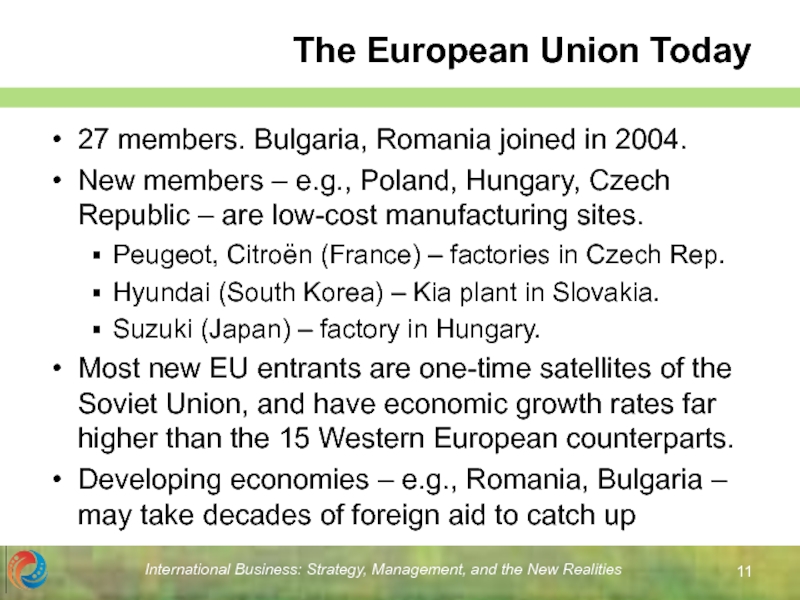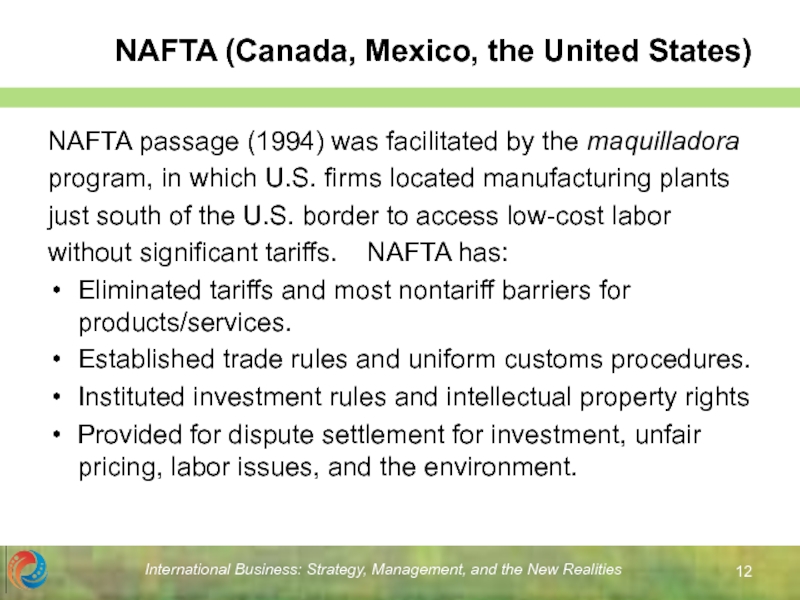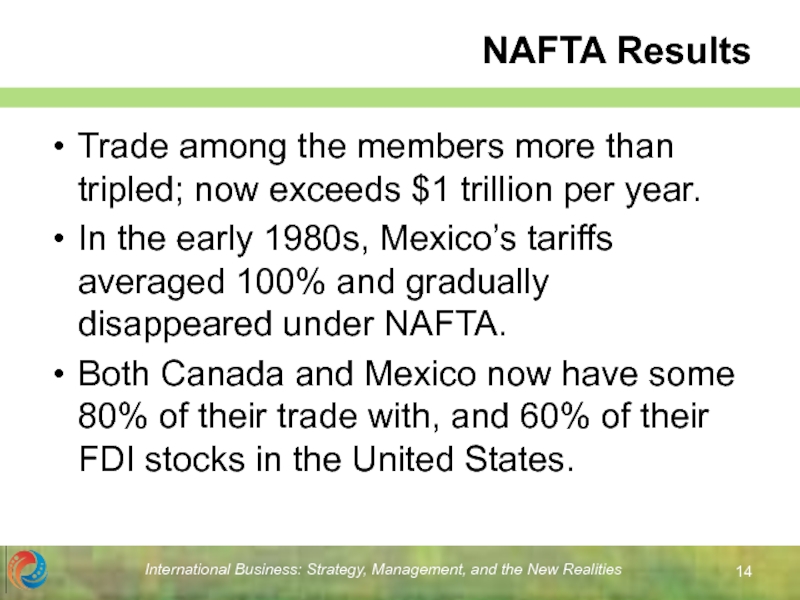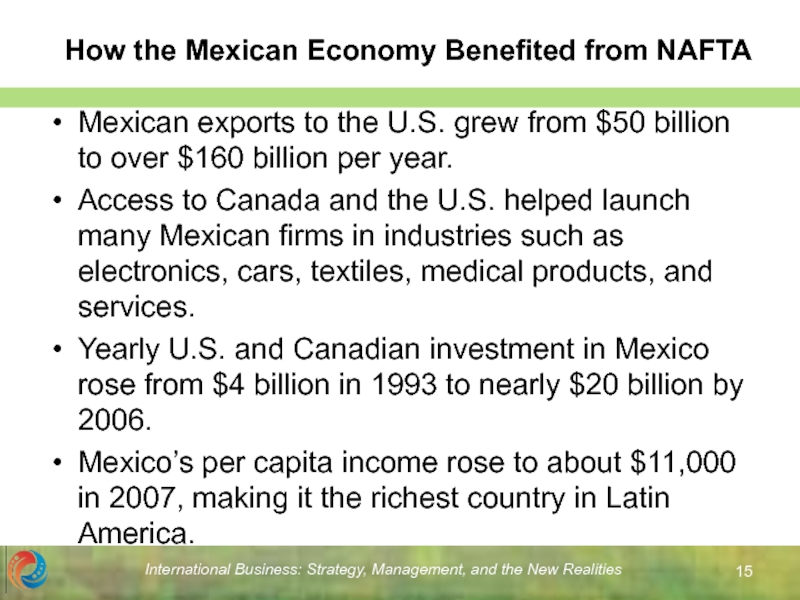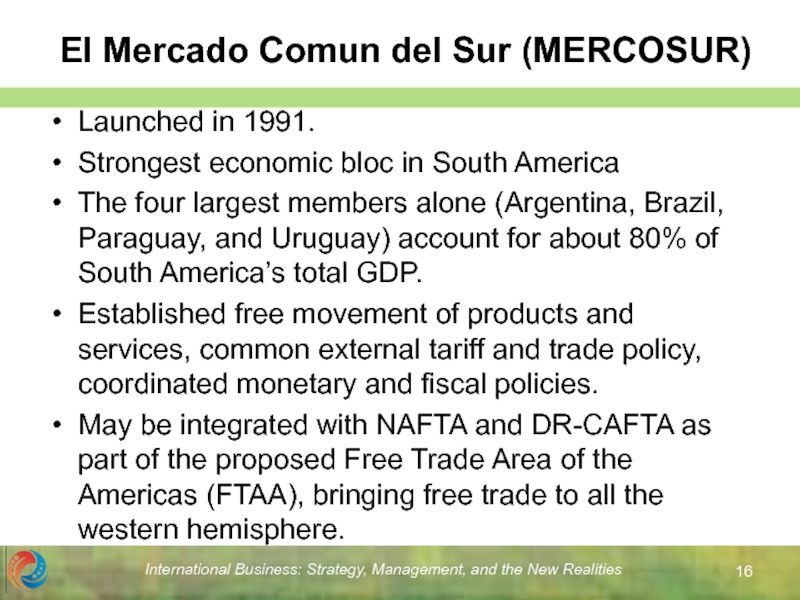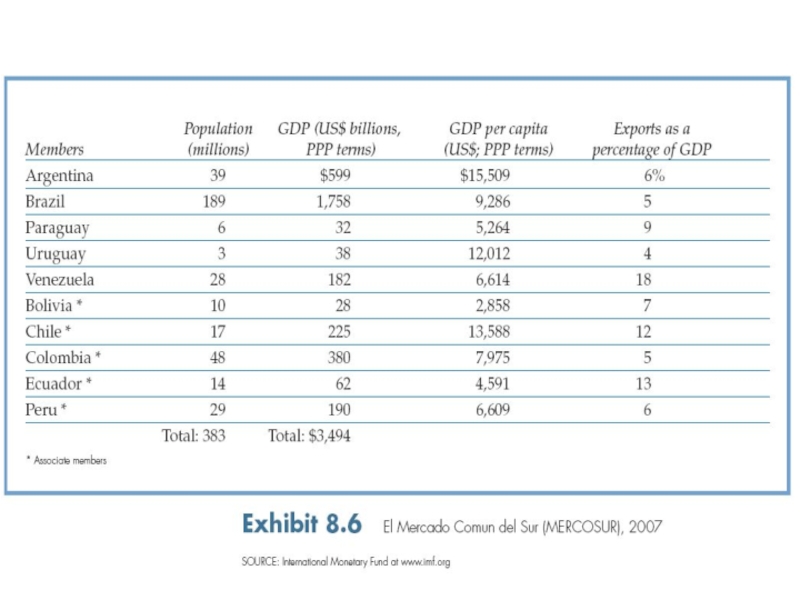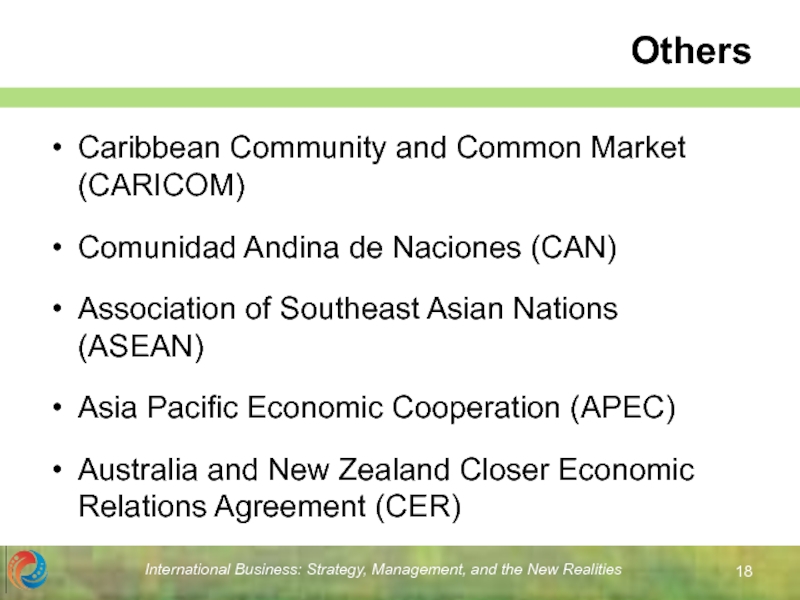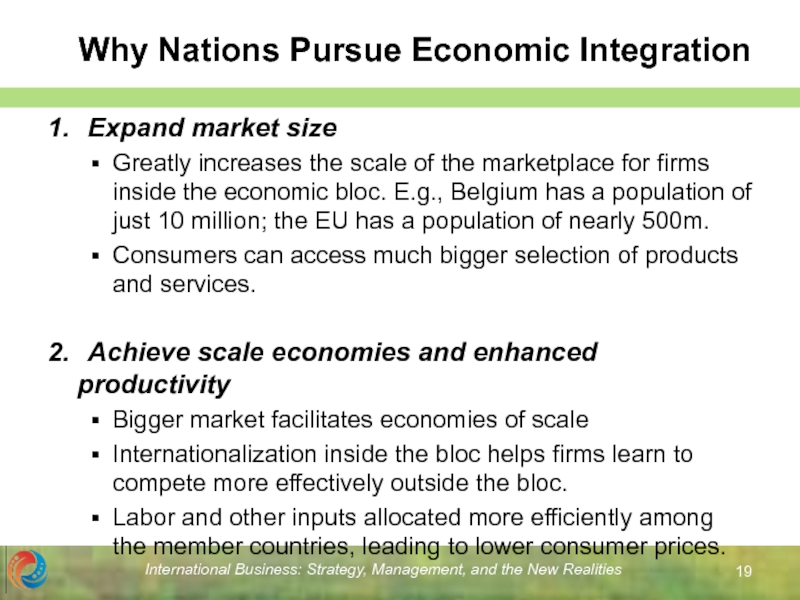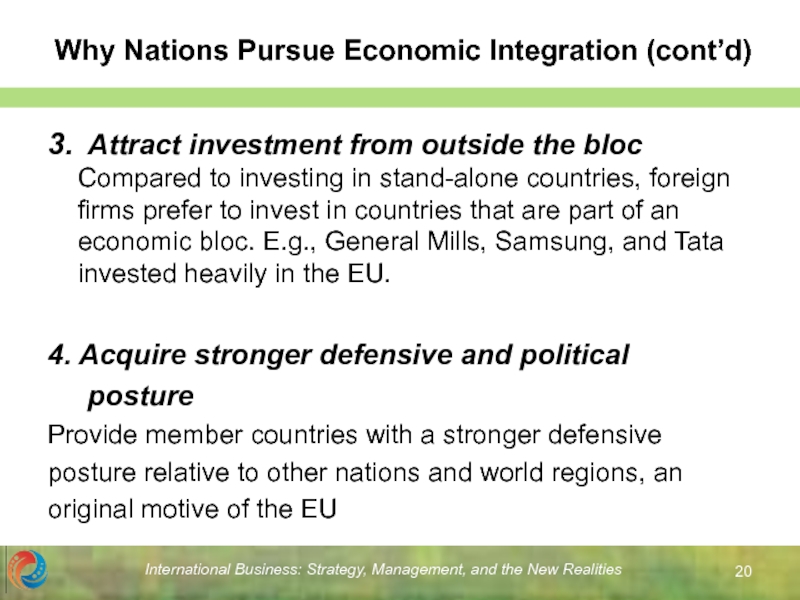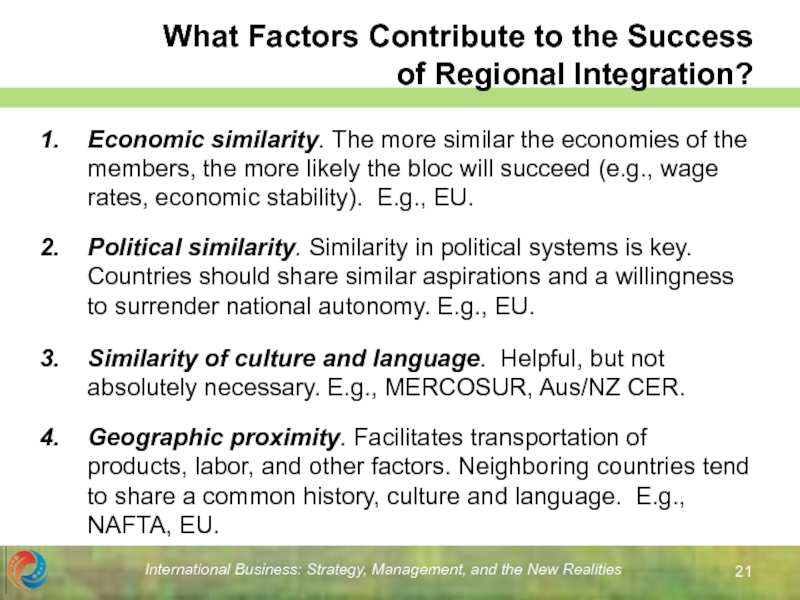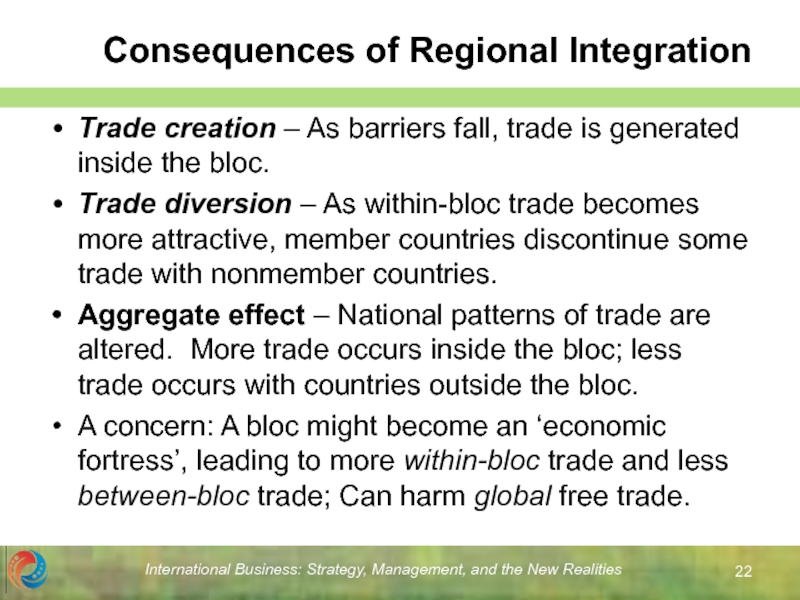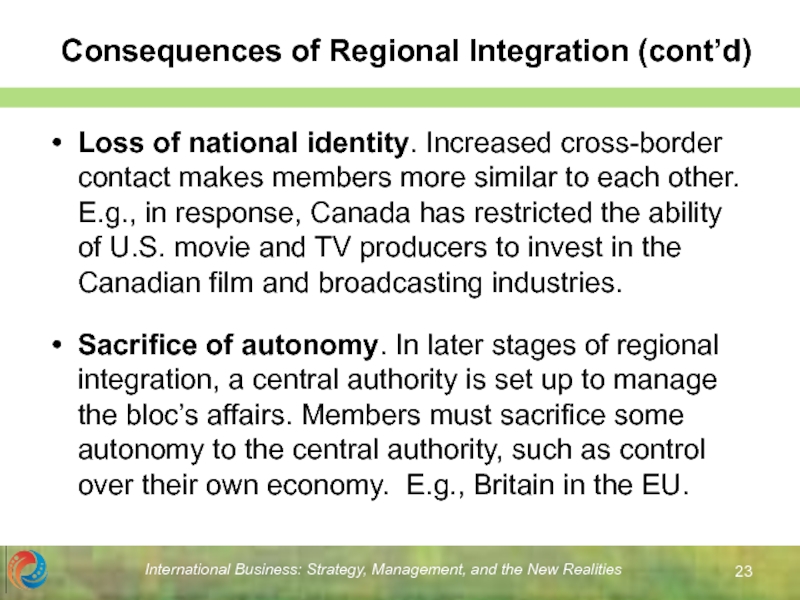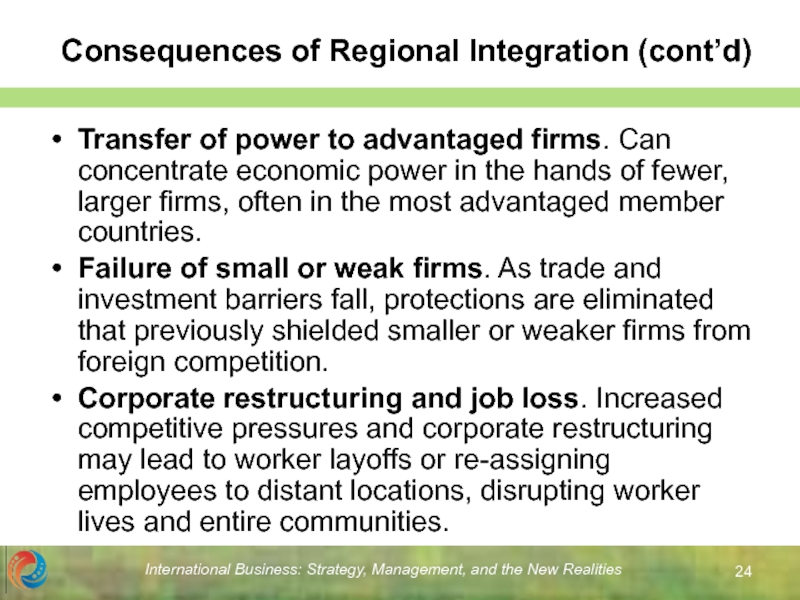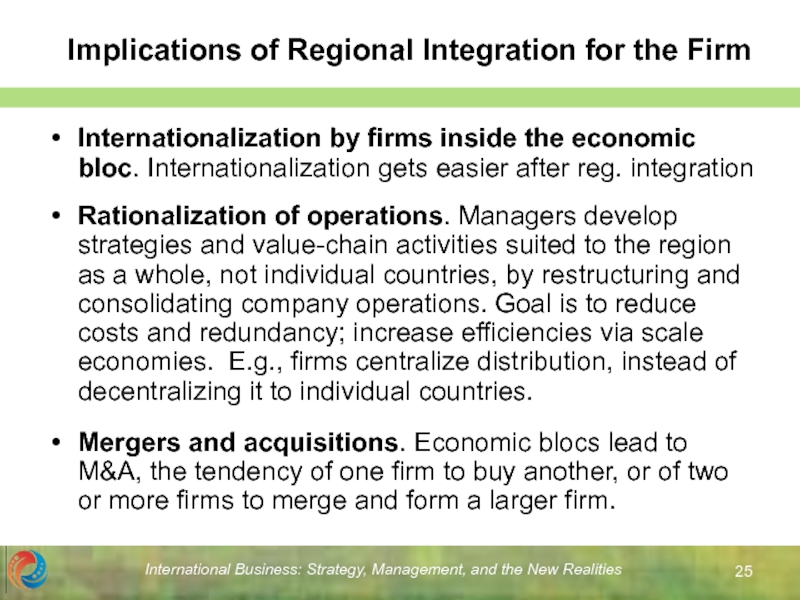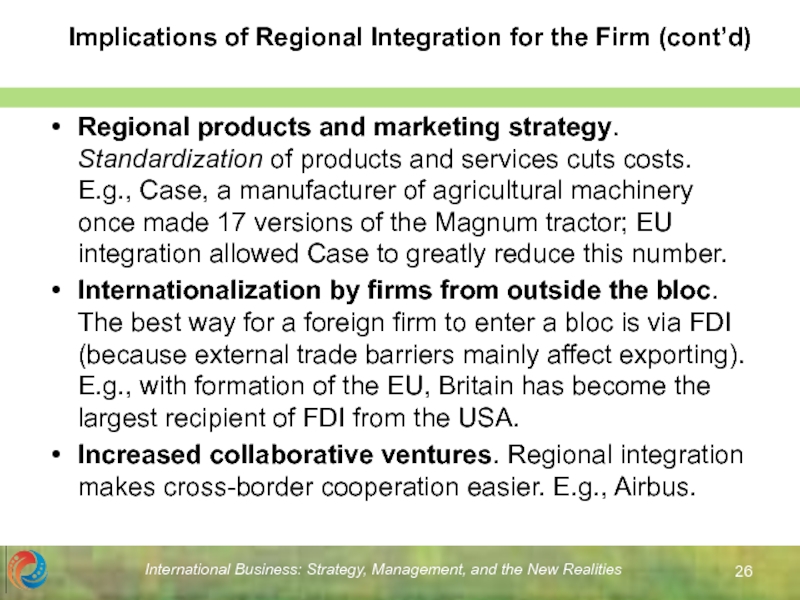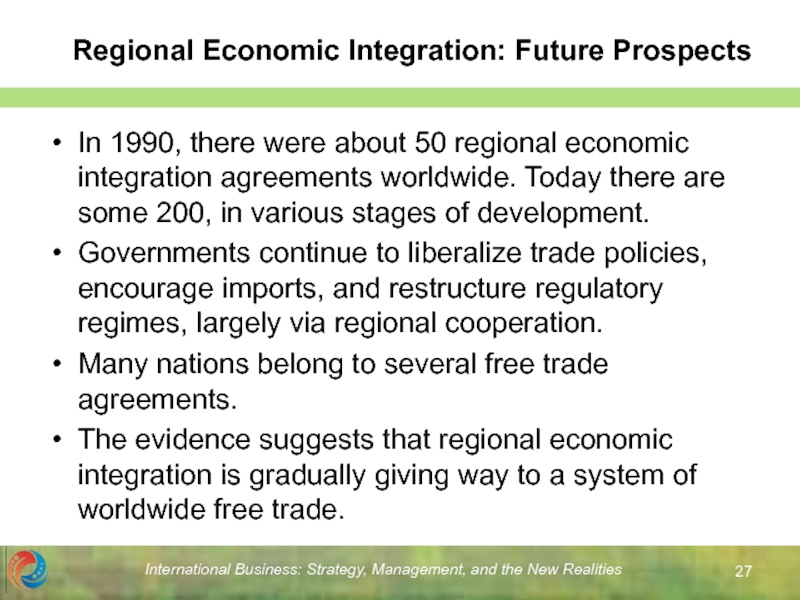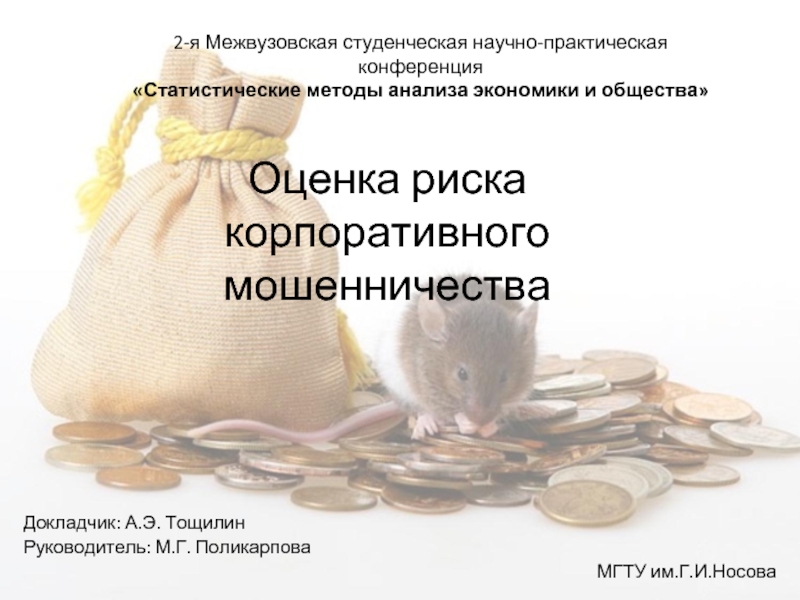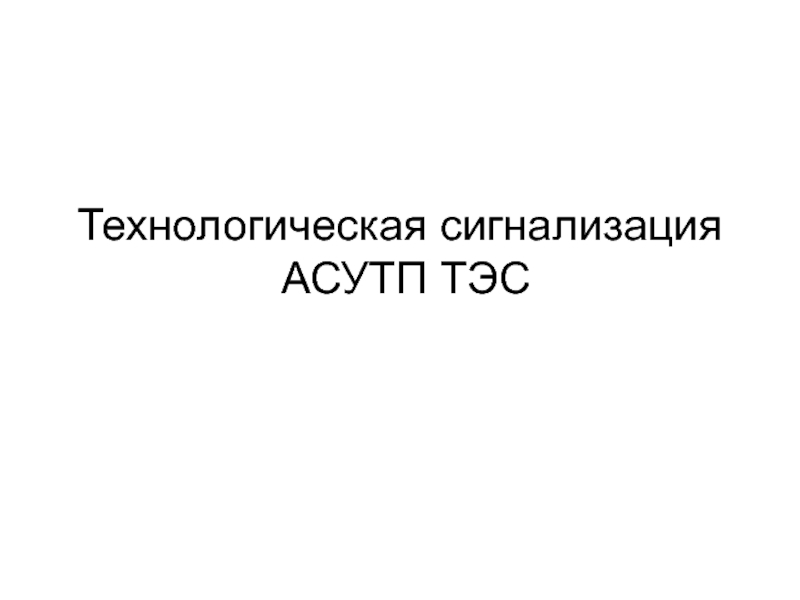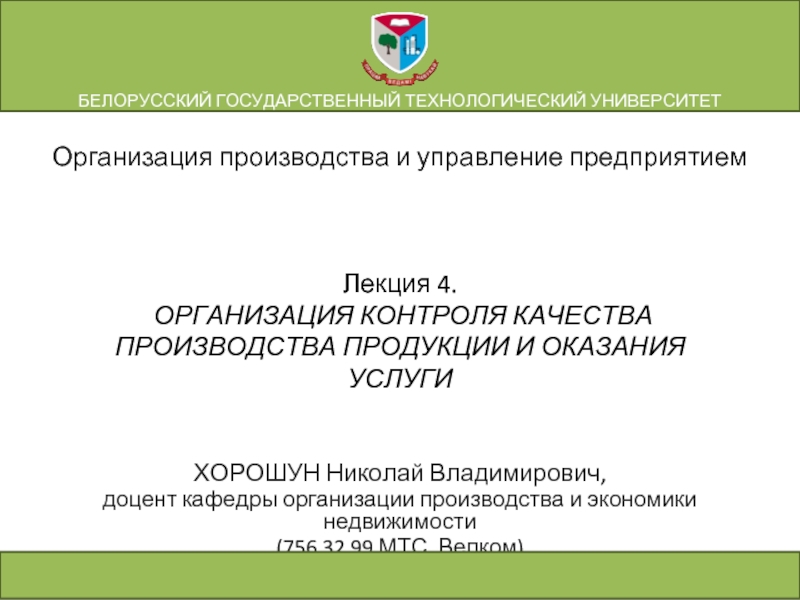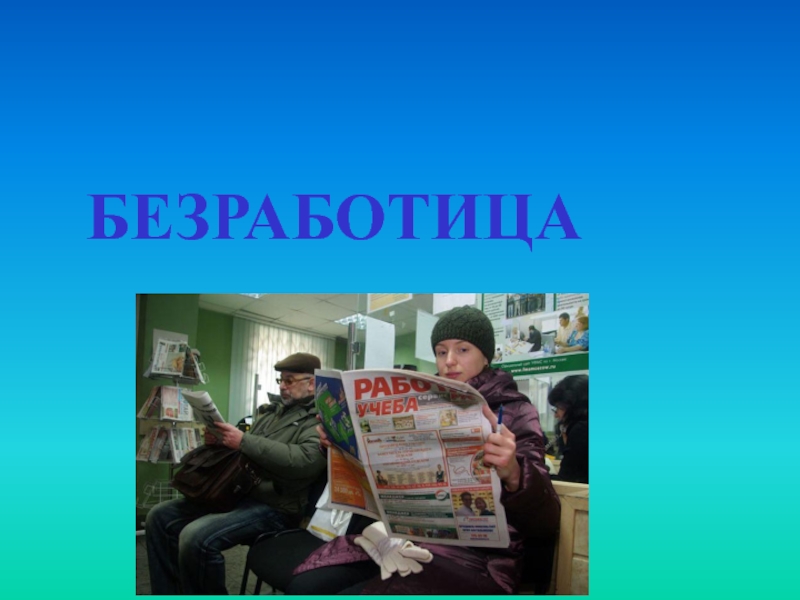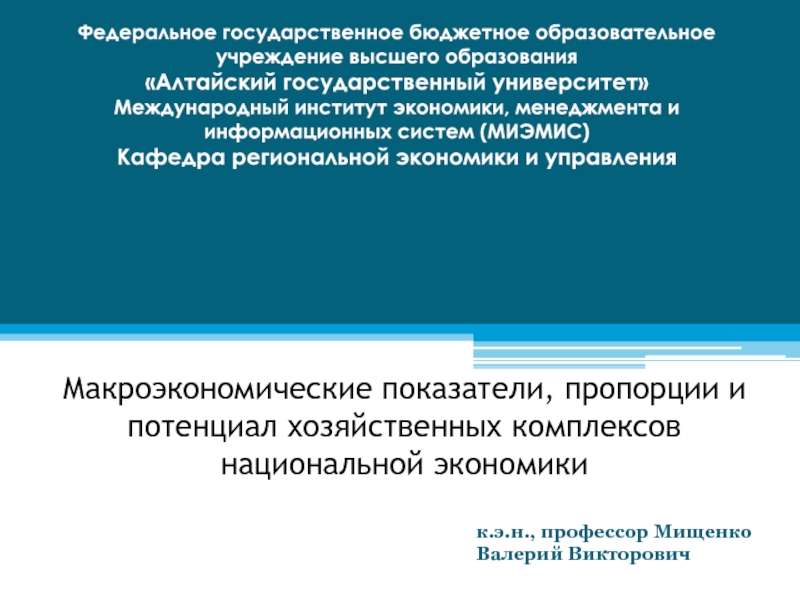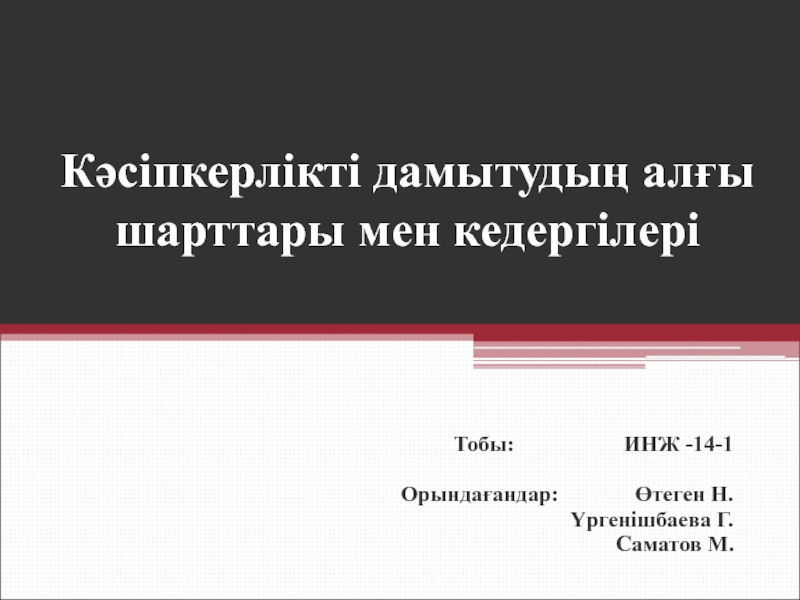Chapter 8
Regional Economic Integration
- Главная
- Разное
- Дизайн
- Бизнес и предпринимательство
- Аналитика
- Образование
- Развлечения
- Красота и здоровье
- Финансы
- Государство
- Путешествия
- Спорт
- Недвижимость
- Армия
- Графика
- Культурология
- Еда и кулинария
- Лингвистика
- Английский язык
- Астрономия
- Алгебра
- Биология
- География
- Детские презентации
- Информатика
- История
- Литература
- Маркетинг
- Математика
- Медицина
- Менеджмент
- Музыка
- МХК
- Немецкий язык
- ОБЖ
- Обществознание
- Окружающий мир
- Педагогика
- Русский язык
- Технология
- Физика
- Философия
- Химия
- Шаблоны, картинки для презентаций
- Экология
- Экономика
- Юриспруденция
Regional Economic Integration презентация
Содержание
- 1. Regional Economic Integration
- 2. International Business: Strategy, Management, and the New
- 3. International Business: Strategy, Management, and the New
- 5. International Business: Strategy, Management, and the New
- 6. International Business: Strategy, Management, and the New
- 7. International Business: Strategy, Management, and the New
- 9. International Business: Strategy, Management, and the New
- 10. International Business: Strategy, Management, and the New
- 11. International Business: Strategy, Management, and the New
- 12. International Business: Strategy, Management, and the New
- 14. International Business: Strategy, Management, and the New
- 15. International Business: Strategy, Management, and the New
- 16. International Business: Strategy, Management, and the New
- 18. International Business: Strategy, Management, and the New
- 19. International Business: Strategy, Management, and the New
- 20. International Business: Strategy, Management, and the New
- 21. International Business: Strategy, Management, and the New
- 22. International Business: Strategy, Management, and the New
- 23. International Business: Strategy, Management, and the New
- 24. International Business: Strategy, Management, and the New
- 25. International Business: Strategy, Management, and the New
- 26. International Business: Strategy, Management, and the New
- 27. International Business: Strategy, Management, and the New
Слайд 1International Business: Strategy, Management, and the New Realities
International Business
Strategy, Management &
Слайд 2International Business: Strategy, Management, and the New Realities
Regional Economic Integration
Growing economic
countries within a geographic region form an alliance
aimed at reducing barriers to trade and investment.
About 40% of world trade now occurs via an economic
bloc agreement.
Cooperating nations obtain:
increased product choices, productivity, living standards;
lower prices; and
more efficient resource use.
Слайд 3International Business: Strategy, Management, and the New Realities
Economic Bloc
A geographic area
countries that agree to pursue economic
integration by reducing tariffs and other restrictions
to cross-border flow of products, services, capital,
and, in more advanced stages, labor.
Examples: European Union (EU), NAFTA,
MERCOSUR, APEC, ASEAN, and many others
There are five possible levels of economic
integration
Слайд 5International Business: Strategy, Management, and the New Realities
Levels of Regional Integration
Free
Customs union: Similar to a free trade area except that the members harmonize their trade policies toward nonmember countries, by enacting common tariff and nontariff barriers on imports from nonmember countries. E.g., MERCOSUR (mainly Argentina, Brazil, Paraguay, and Uruguay)
Слайд 6International Business: Strategy, Management, and the New Realities
Levels of Regional Integration
3. Common market (single market): Like a customs union, except products, services, and factors of production such as capital, labor, and technology can move freely among the member countries. E.g., the EU. requires much cooperation among the member countries on labor and economic policies.
4. Economic union: Like a common market, but members also aim for common fiscal and monetary policies, standardized commercial regulations, social policy, etc. E.g., the EU is moving toward economic union by forming a monetary union with a single currency, the euro.
Слайд 7International Business: Strategy, Management, and the New Realities
Levels of Regional Integration
5. Political union
Perfect unification of all policies by a common organization. Submersion of all separate national institutions.
Remains an ideal, yet to be achieved.
Слайд 9International Business: Strategy, Management, and the New Realities
The EU: Features
Market access. Tariffs and most nontariff barriers have been eliminated.
Common market. Removed barriers to cross-national movement of production factors—labor, capital, and technology.
Trade rules. Eliminated customs procedures and regulations, streamlining transportation and logistics within Europe.
Standards harmonization. Harmonizing technical standards, regulations, and enforcement procedures on products, services, and commercial activities.
Common fiscal, monetary, taxation, and social welfare policies, in the long run.
Слайд 10International Business: Strategy, Management, and the New Realities
Four Institutions that Govern
Council of the European Union. The main decision-making
body. Makes decisions on economic policy, budgets, and foreign
policy, and admission of new member countries.
European Commission. Represents the interests of the EU as
a whole. Proposes legislation. Responsible for implementing
decisions of the Parliament and the Council.
European Parliament. Up to 732 representatives. Hold joint
sessions each month. Three main functions:
1. Devise EU legislation,
2. Supervise EU institutions, and
3. Make decisions on the EU budget.
European Court of Justice. Interprets and enforces EU laws
and settles legal disputes between member states.
Слайд 11International Business: Strategy, Management, and the New Realities
The European Union Today
27
New members – e.g., Poland, Hungary, Czech Republic – are low-cost manufacturing sites.
Peugeot, Citroën (France) – factories in Czech Rep.
Hyundai (South Korea) – Kia plant in Slovakia.
Suzuki (Japan) – factory in Hungary.
Most new EU entrants are one-time satellites of the Soviet Union, and have economic growth rates far higher than the 15 Western European counterparts.
Developing economies – e.g., Romania, Bulgaria – may take decades of foreign aid to catch up
Слайд 12International Business: Strategy, Management, and the New Realities
NAFTA (Canada, Mexico, the
NAFTA passage (1994) was facilitated by the maquilladora
program, in which U.S. firms located manufacturing plants
just south of the U.S. border to access low-cost labor
without significant tariffs. NAFTA has:
Eliminated tariffs and most nontariff barriers for products/services.
Established trade rules and uniform customs procedures.
Instituted investment rules and intellectual property rights
Provided for dispute settlement for investment, unfair pricing, labor issues, and the environment.
Слайд 14International Business: Strategy, Management, and the New Realities
NAFTA Results
Trade among
In the early 1980s, Mexico’s tariffs averaged 100% and gradually disappeared under NAFTA.
Both Canada and Mexico now have some 80% of their trade with, and 60% of their FDI stocks in the United States.
Слайд 15International Business: Strategy, Management, and the New Realities
How the Mexican Economy
Mexican exports to the U.S. grew from $50 billion to over $160 billion per year.
Access to Canada and the U.S. helped launch many Mexican firms in industries such as electronics, cars, textiles, medical products, and services.
Yearly U.S. and Canadian investment in Mexico rose from $4 billion in 1993 to nearly $20 billion by 2006.
Mexico’s per capita income rose to about $11,000 in 2007, making it the richest country in Latin America.
Слайд 16International Business: Strategy, Management, and the New Realities
El Mercado Comun del
Launched in 1991.
Strongest economic bloc in South America
The four largest members alone (Argentina, Brazil, Paraguay, and Uruguay) account for about 80% of South America’s total GDP.
Established free movement of products and services, common external tariff and trade policy, coordinated monetary and fiscal policies.
May be integrated with NAFTA and DR-CAFTA as part of the proposed Free Trade Area of the Americas (FTAA), bringing free trade to all the western hemisphere.
Слайд 18International Business: Strategy, Management, and the New Realities
Others
Caribbean Community and Common
Comunidad Andina de Naciones (CAN)
Association of Southeast Asian Nations (ASEAN)
Asia Pacific Economic Cooperation (APEC)
Australia and New Zealand Closer Economic Relations Agreement (CER)
Слайд 19International Business: Strategy, Management, and the New Realities
Why Nations Pursue Economic
1. Expand market size
Greatly increases the scale of the marketplace for firms inside the economic bloc. E.g., Belgium has a population of just 10 million; the EU has a population of nearly 500m.
Consumers can access much bigger selection of products and services.
2. Achieve scale economies and enhanced productivity
Bigger market facilitates economies of scale
Internationalization inside the bloc helps firms learn to compete more effectively outside the bloc.
Labor and other inputs allocated more efficiently among the member countries, leading to lower consumer prices.
Слайд 20International Business: Strategy, Management, and the New Realities
Why Nations Pursue Economic
3. Attract investment from outside the bloc
Compared to investing in stand-alone countries, foreign firms prefer to invest in countries that are part of an economic bloc. E.g., General Mills, Samsung, and Tata invested heavily in the EU.
4. Acquire stronger defensive and political
posture
Provide member countries with a stronger defensive
posture relative to other nations and world regions, an
original motive of the EU
Слайд 21International Business: Strategy, Management, and the New Realities
What Factors Contribute to
Economic similarity. The more similar the economies of the members, the more likely the bloc will succeed (e.g., wage rates, economic stability). E.g., EU.
Political similarity. Similarity in political systems is key. Countries should share similar aspirations and a willingness to surrender national autonomy. E.g., EU.
Similarity of culture and language. Helpful, but not absolutely necessary. E.g., MERCOSUR, Aus/NZ CER.
Geographic proximity. Facilitates transportation of products, labor, and other factors. Neighboring countries tend to share a common history, culture and language. E.g., NAFTA, EU.
Слайд 22International Business: Strategy, Management, and the New Realities
Consequences of Regional Integration
Trade
Trade diversion – As within-bloc trade becomes more attractive, member countries discontinue some trade with nonmember countries.
Aggregate effect – National patterns of trade are altered. More trade occurs inside the bloc; less trade occurs with countries outside the bloc.
A concern: A bloc might become an ‘economic fortress’, leading to more within-bloc trade and less between-bloc trade; Can harm global free trade.
Слайд 23International Business: Strategy, Management, and the New Realities
Consequences of Regional Integration
Loss of national identity. Increased cross-border contact makes members more similar to each other. E.g., in response, Canada has restricted the ability of U.S. movie and TV producers to invest in the Canadian film and broadcasting industries.
Sacrifice of autonomy. In later stages of regional integration, a central authority is set up to manage the bloc’s affairs. Members must sacrifice some autonomy to the central authority, such as control over their own economy. E.g., Britain in the EU.
Слайд 24International Business: Strategy, Management, and the New Realities
Consequences of Regional Integration
Transfer of power to advantaged firms. Can concentrate economic power in the hands of fewer, larger firms, often in the most advantaged member countries.
Failure of small or weak firms. As trade and investment barriers fall, protections are eliminated that previously shielded smaller or weaker firms from foreign competition.
Corporate restructuring and job loss. Increased competitive pressures and corporate restructuring may lead to worker layoffs or re-assigning employees to distant locations, disrupting worker lives and entire communities.
Слайд 25International Business: Strategy, Management, and the New Realities
Implications of Regional Integration
Internationalization by firms inside the economic bloc. Internationalization gets easier after reg. integration
Rationalization of operations. Managers develop strategies and value-chain activities suited to the region as a whole, not individual countries, by restructuring and consolidating company operations. Goal is to reduce costs and redundancy; increase efficiencies via scale economies. E.g., firms centralize distribution, instead of decentralizing it to individual countries.
Mergers and acquisitions. Economic blocs lead to M&A, the tendency of one firm to buy another, or of two or more firms to merge and form a larger firm.
Слайд 26International Business: Strategy, Management, and the New Realities
Implications of Regional Integration
Regional products and marketing strategy. Standardization of products and services cuts costs. E.g., Case, a manufacturer of agricultural machinery once made 17 versions of the Magnum tractor; EU integration allowed Case to greatly reduce this number.
Internationalization by firms from outside the bloc. The best way for a foreign firm to enter a bloc is via FDI (because external trade barriers mainly affect exporting). E.g., with formation of the EU, Britain has become the largest recipient of FDI from the USA.
Increased collaborative ventures. Regional integration makes cross-border cooperation easier. E.g., Airbus.
Слайд 27International Business: Strategy, Management, and the New Realities
Regional Economic Integration: Future
In 1990, there were about 50 regional economic integration agreements worldwide. Today there are some 200, in various stages of development.
Governments continue to liberalize trade policies, encourage imports, and restructure regulatory regimes, largely via regional cooperation.
Many nations belong to several free trade agreements.
The evidence suggests that regional economic integration is gradually giving way to a system of worldwide free trade.

